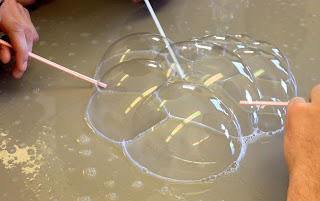 |
| Bubbles--Indoor Science Activity |
You will need Dawn dish detergent, water, plastic straws, measuring tape, a water resistant counter top or cookie sheet, and towels to clean up.
Making Bubbles
Clean a counter top and wet it with a
 |
| Wet Counter-top-Add a Few Drops of Detergent |
puddle of less than 1/8 cup of water. Place 3-5 drops of dish detergent on the puddle and spread around with your hand (fingers curved) until you have some small bubbles.
Wet the tip of a straw in your bubble solution and gently place that tip at a 45-degree angle where the bubble meets the counter.
Slowly blow into the small bubble.
 |
| Gently Blow Into the Soapy Puddle |
The bubble will enlarge as long as the bubble stays in the soapy solution. Bubbles can reach a foot or more in diameter.
Soap solution molecules link together. When children blow air into bubbles, the soap solution stretches and surrounds the air. We see bubble colors when light is bent similar to a rainbow.
To make smaller bubbles inside larger bubbles, dip the straw in the table solution and gently blow inside the larger bubble.
At first no one will get a bubble, and suddenly your counter top is full of bubbles.
Practice making bigger and bigger bubbles. When they pop, measure the diameter of the bubbles edge to edge through the center.
Refresh solution
Refresh solution
If the solution stops working, add more solution or more water until you get many small bubbles when you swish it around with curved fingers. if the solution is white when you spread it around clean up and start over.
What colors do you see in the bubbles? What color does a section of the bubble become the moment before there is a hole and that section bursts? (red, the thinnest part of the bubble skin)
 |
| Ask Questions, Experiment, Have Fun! |
Who can make the most bubbles inside a larger bubble? Can you move the bubble? Can you join it with another bubble? Predict what will happen if you move the bubble to a dry spot. Can you pick it up in your hand? Can you carefully place your soapy hand inside a bubble and keep blowing to surround your hand?
Teach very young children (age two) to blow OUT gently. They will generally like to burst bubbles rather than make them. Give them a cup or large bowl with solution.
They will enjoy making bubble volcanoes or dipping their straw in the solution and making small bubbles in their hand or in the air.
By Jean Hetrick
website: Also check our audio Podcasts WNMU Radio, 90; Youtube
Photos: Fran Darling, fdarling fotos
More Vocabulary Ideas and Activities....See the authors’ book “Learning Through the Seasons” at area bookstores and grandparentsteachtoo.org. For more help to prepare young children for success in school see the authors’
No comments:
Post a Comment